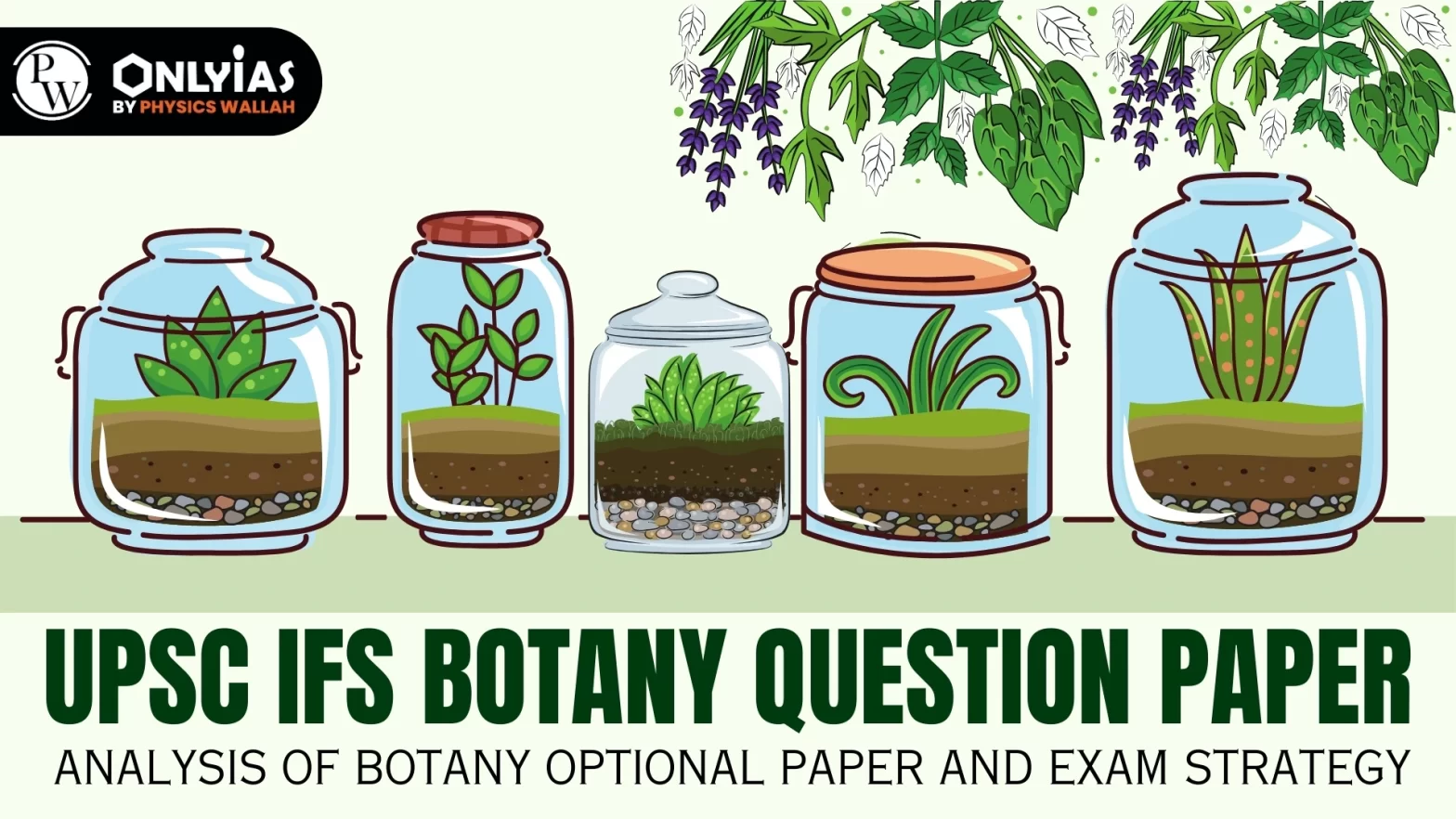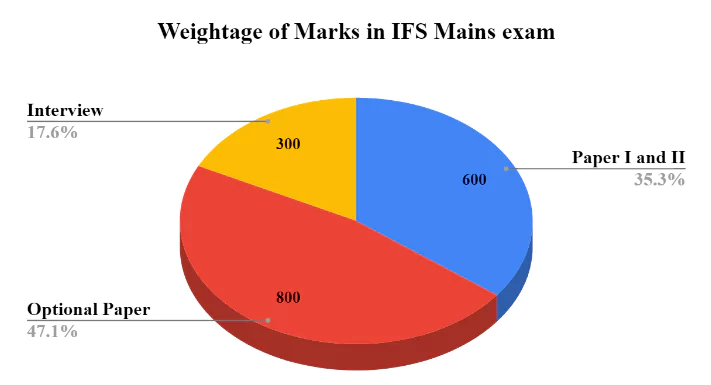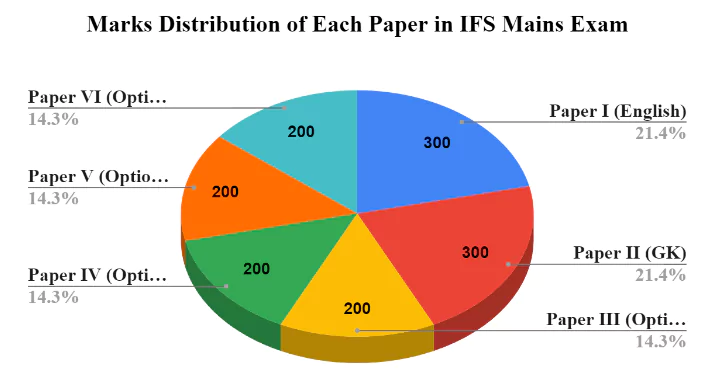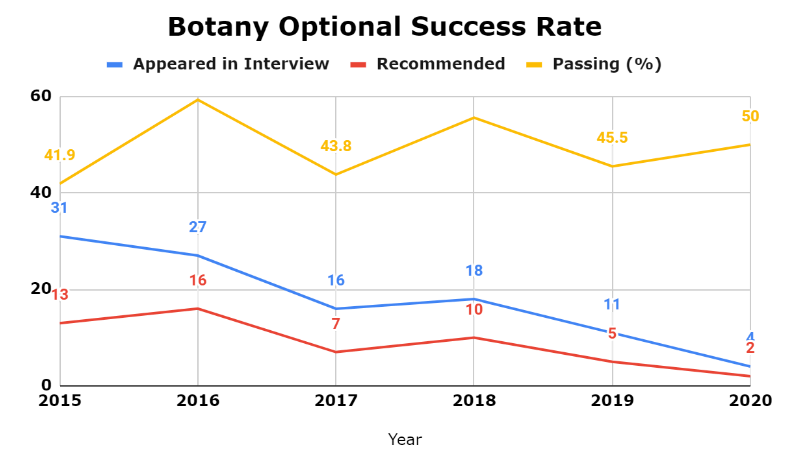Exploring the UPSC IFS Mains with Botany as your optional subject. Discover its significance, success rates, paper trends, and strategic benefits. Receive book recommendations for efficient preparation to boost your chances of success.

The UPSC IFS mains consist of a total of six papers with a total of 1400 marks. The IFS Mains examination includes two papers: one on English and one on General Knowledge. The remaining four papers (Paper I, Paper II, Paper III and Paper IV) cover optional subjects that candidates have chosen during the application form filling process. Since Paper I and Paper II have a maximum of 300 marks each, the remaining 800 marks depend on the optional subjects. It becomes crucial to choose the right optional subject and employ the right strategy so that candidates can score as much as possible. First, we will explore the importance and weightage of optionals, and then we will analyze the Botany Question Paper as an optional subject.
| Download IFS 2023 Botany Optional Paper-01 Download IFS 2023 Botany Optional Paper-02 |
In UPSC IFS mains examination candidates have to choose two optional subjects from the list specified in the notification unlike UPSC IAS mains exam in which candidate has to choose only one optional subject. In IFS exam optional subjects have very high scoring potential because after Paper I and Paper II which consist of 600 marks optional have 800 marks so here optional plays a decisive role in determining your selection as well as to achieve a good rank.

It is evident that in the entire selection process, the optional subject plays a crucial role in preparing for the UPSC IFS exam, as it accounts for almost 48% of the total marks. This substantial portion contributes significantly to the overall evaluation of the entire exam.

Upon further magnification, we can conclude that in the IFS mains examination, the optional section carries almost 58% of the total mains marks. Therefore, scoring well in the optional section, along with Paper I and Paper II, will result in higher overall marks in the exam.
In the UPSC IFS Mains exam, Botany Question Paper subject consists of two papers, specifically Paper I and Paper II. Each of these papers carries a weightage of 200 marks, summing up to a total of 400 marks for this optional subject. Among the various optional subjects offered by UPSC in IFS, Botany Question Paper is one of the 14 optional subjects available to candidates.
| Botany | Syllabus |
| Paper I | Microbiology and Plant Pathology: Viruses, bacteria, and plasmids-structure and reproduction. General account of infection, Phytoimmunology. Applications of microbiology in agriculture, industry, medicine and pollution control in air, soil and water. Important plant diseases caused by viruses, bacteria, mycoplasma, fungi and nematodes. Mode of infection and dissemination. Molecular basis of infection and disease resistance/ defence. Physiology of parasitism and control measures. Fungal toxins.
Cryptogams: Algae, Fungi, Bryophytes, Pteridophytes-structure and reproduction from evolutonary viewpoint. Distribution of Cryptogams in India and their economic potential. Phanerogams: Gymnosperms: Concept of Progymonosperms. Classification and distribution of Gymnosperms. Salient features of Cycadales, Coniferrals and Gnetales, their structures and reproduction. General account of Cycadofilicales, Bennettitales and Cordaitales. Angiosperms: Systematics, anatomy, embryology, palynology and phylogeny. Comparative account of various systems of Angiosperm Classiification. Study of angiospermic families-Magnoliaceae, Ranunculaceae, Brassicaceae (Cruciferae), Rosaceae, Leguminosae, Euphorbiaceae, Malvaceaie, Dipterocarpaceae, Apiaceae (Umbelliferae), Asclepiadaceae, Verbenaceae, Solanaceae, Rubiaceae, Cucurbitaceae, Asteraceae (Composite), Poaceae (Gramineae), Arecaceae (Palmae), Liliaceae, Musaceae, Orchidaceae. Stomata and their types. Anomalous secondary growth, Anatomy of C 3 and C 4 plants. Development of male and female gametophytes, pollination, fertilization. Endospermits development and function. Patterns of embryo development. Polyembryony, apoxmix, Applications of palynology. Plant Utility and Exploitation: Origin of cultivated plants, Vavilov’s centres of origin. Plants as sources for food, fodder, fibres, spices, beverages, drugs, narcotics, insecticides, timber, gums, resins and dyes. Latex, cellulose Starch and their products. Perfumery. Importance of Ethnobotany in Indian context. Energy plantation. Botanical Gardens and Herbaria. Morphogenesis: Totipotency, polarity, symmetry and differentiation. Cell, tissue, organ and protoplast culture. Somatic hybrids and Cybrids. |
| Paper II | Cell Biology: Techniques of Cell Biology. Prokaryotic and eukaryotic cells – structural and ultra structural details. Structure and function of extra cellular matrix or ECM (cell wall) and membranes cell adhesion, membrane transport and vesicular transport. Structure and function of cell organelles (chloroplasts, mitochondria, ER, ribosome’s, embosoms, lissome, peroxisomes, hydrogeno-some). Nucleus, nucleolus, nuclear pore complex. Chromatin and nucleosome. Cell signalling and cell receptors. Signal transduction (G-1 proteins, etc.). Mitosis and meisdosis; molecular basis of cell cycle. Numerical and structural variations in chromosomes and their significance. Study of polygene, lamp brush and B-chromosomes-structure, behaviour and significance.
Genetics, Molecular Biology and Evolution: Development of genetics, and gene versus allele concepts (Pseudo alleles). Quantitative genetics and multiple factors. Linkage and crossing over-methods of gene mapping including molecular maps (idea of mapping function). Sex chromosomes and sex linked inheritance, sex determination and molecular basis of sex differentiation. Mutation (biochemical and molecular basis). Cytoplasmic inheritance and cytoplasmic genes (including genetics of male sterility). Prions and prion hypothesis. Structure and synthesis of nucleic acids and proteins. Genetic code and regulation of gene expression. Multigene families. Organic evolution-evidences, mechanism and theories. Role of RNA in origin and evolution. Plant Breeding, Biotechnology and Biostatistics: Methods of plant breedingintroduction, selection and hybridization (pedigree, backcross, mass selection, bulk method). Male sterility and heterosis breeding. Use of apomixes in plant breeding. Micro propagation and genetic engineering-methods of transfer of genes and transgenic crops; development and use of molecular markers in plant breeding. Standard deviation and coefficient of variation (CV). Tests of significance (Z-test, t-test and chi-square tests). Probability and distributions (normal, binomial and Poisson distributions). Correlation and regression. Physiology and Biochemistry: Water relations, Mineral nutrition and ion transport, mineral deficiencies. Photosynthesis-photochemical reactions, photophosphorylation and carbon pathways including C pathway (photorespiration), C, C and CAM pathways. Respiration (anaerobic and aerobic, including fermentationelectron transport chain and oxidative phosphorylation. Chemiosmotic theory and ATP synthesis. Nitrogen fixation and nitrogen metabolism. Enzymes, coenzymes, |
UPSC Botany Question Paper from 2018 to 2022 are readily available for aspirants seeking to enhance their preparation. We provided access to the UPSC IFS Botany Question Paper in PDF format, an invaluable resource for your preparation.
| Year | Paper |
| UPSC IFS Botany Question Paper 2018 | Paper I |
| UPSC IFS Botany Question Paper 2019 | Paper I |
| UPSC IFS Botany Question Paper 2020 | Paper I |
| UPSC IFS Botany Question Paper 2021 | Paper I |
| UPSC IFS Botany Question Paper 2022 | Paper I |
Candidates appearing for the UPSC (Union Public Service Commission) IFS examination must make a thoughtful choice when selecting their optional subject, as it holds substantial weightage in the evaluation process. With a total of 800 marks allotted, the optional subject constitutes approximately 48% of the combined marks for both the written exam and the personality test.
The table below offers a comprehensive overview of the success rate achieved by candidates who opted for Botany Question Paper as their optional.
| Year | Number of Candidates | ||
| Appeared in Interview | Recommended | Passing (%) | |
| 2015 | 31 | 13 | 41.9 |
| 2016 | 27 | 16 | 59.3 |
| 2017 | 16 | 7 | 43.8 |
| 2018 | 18 | 10 | 55.6 |
| 2019 | 11 | 5 | 45.5 |
| 2020 | 4 | 2 | 50 |

Please note that before selecting botany as your optional subject, carefully weigh these disadvantages against the advantages and consider your own background, interests, and the time you can dedicate to preparation.
| Must Read | |
| NCERT Notes For UPSC | UPSC Daily Current Affairs |
| UPSC Blogs | UPSC Daily Editorials |
| Daily Current Affairs Quiz | Daily Main Answer Writing |
| UPSC Mains Previous Year Papers | UPSC Test Series 2024 |
No, both subjects have different syllabus.
There are two papers of Botany each paper divided into two parts.
Yes you can choose both subjects.

<div class="new-fform">
</div>